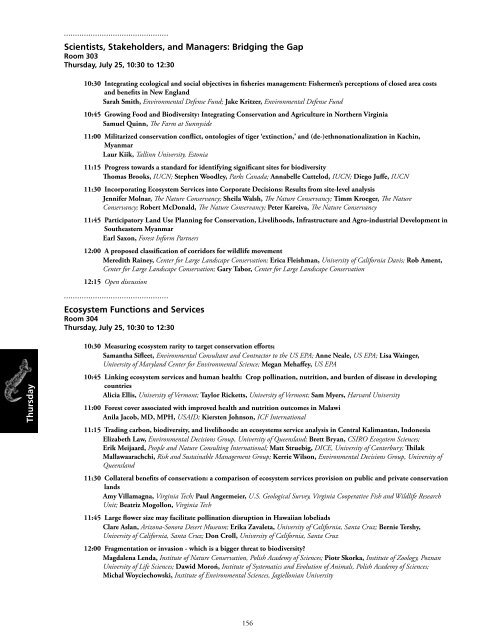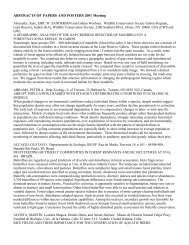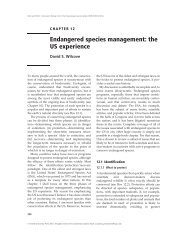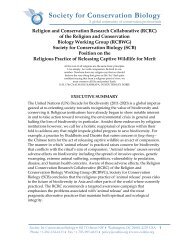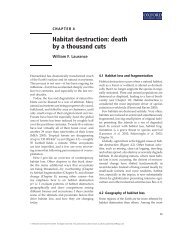ICCB 2013 Program - Society for Conservation Biology
ICCB 2013 Program - Society for Conservation Biology
ICCB 2013 Program - Society for Conservation Biology
Create successful ePaper yourself
Turn your PDF publications into a flip-book with our unique Google optimized e-Paper software.
...............................................<br />
Scientists, Stakeholders, and Managers: Bridging the Gap<br />
Room 303<br />
Thursday, July 25, 10:30 to 12:30<br />
10:30 Integrating ecological and social objectives in fisheries management: Fishermen’s perceptions of closed area costs<br />
and benefits in New England<br />
Sarah Smith, Environmental Defense Fund; Jake Kritzer, Environmental Defense Fund<br />
10:45 Growing Food and Biodiversity: Integrating <strong>Conservation</strong> and Agriculture in Northern Virginia<br />
Samuel Quinn, The Farm at Sunnyside<br />
11:00 Militarized conservation conflict, ontologies of tiger ‘extinction,’ and (de-)ethnonationalization in Kachin,<br />
Myanmar<br />
Laur Kiik, Tallinn University, Estonia<br />
11:15 Progress towards a standard <strong>for</strong> identifying significant sites <strong>for</strong> biodiversity<br />
Thomas Brooks, IUCN; Stephen Woodley, Parks Canada; Annabelle Cuttelod, IUCN; Diego Juffe, IUCN<br />
11:30 Incorporating Ecosystem Services into Corporate Decisions: Results from site-level analysis<br />
Jennifer Molnar, The Nature Conservancy; Sheila Walsh, The Nature Conservancy; Timm Kroeger, The Nature<br />
Conservancy; Robert McDonald, The Nature Conservancy; Peter Kareiva, The Nature Conservancy<br />
11:45 Participatory Land Use Planning <strong>for</strong> <strong>Conservation</strong>, Livelihoods, Infrastructure and Agro-industrial Development in<br />
Southeastern Myanmar<br />
Earl Saxon, Forest In<strong>for</strong>m Partners<br />
12:00 A proposed classification of corridors <strong>for</strong> wildlife movement<br />
Meredith Rainey, Center <strong>for</strong> Large Landscape <strong>Conservation</strong>; Erica Fleishman, University of Cali<strong>for</strong>nia Davis; Rob Ament,<br />
Center <strong>for</strong> Large Landscape <strong>Conservation</strong>; Gary Tabor, Center <strong>for</strong> Large Landscape <strong>Conservation</strong><br />
12:15 Open discussion<br />
...............................................<br />
Ecosystem Functions and Services<br />
Room 304<br />
Thursday, July 25, 10:30 to 12:30<br />
Thursday<br />
10:30 Measuring ecosystem rarity to target conservation ef<strong>for</strong>ts;<br />
Samantha Sifleet, Environmental Consultant and Contractor to the US EPA; Anne Neale, US EPA; Lisa Wainger,<br />
University of Maryland Center <strong>for</strong> Environmental Science; Megan Mehaffey, US EPA<br />
10:45 Linking ecosystem services and human health: Crop pollination, nutrition, and burden of disease in developing<br />
countries<br />
Alicia Ellis, University of Vermont; Taylor Ricketts, University of Vermont; Sam Myers, Harvard University<br />
11:00 Forest cover associated with improved health and nutrition outcomes in Malawi<br />
Anila Jacob, MD, MPH, USAID; Kiersten Johnson, ICF International<br />
11:15 Trading carbon, biodiversity, and livelihoods: an ecosystems service analysis in Central Kalimantan, Indonesia<br />
Elizabeth Law, Environmental Decisions Group, University of Queensland; Brett Bryan, CSIRO Ecosystem Sciences;<br />
Erik Meijaard, People and Nature Consulting International; Matt Struebig, DICE, University of Canterbury; Thilak<br />
Mallawaarachchi, Risk and Sustainable Management Group; Kerrie Wilson, Environmental Decisions Group, University of<br />
Queensland<br />
11:30 Collateral benefits of conservation: a comparison of ecosystem services provision on public and private conservation<br />
lands<br />
Amy Villamagna, Virginia Tech; Paul Angermeier, U.S. Geological Survey, Virginia Cooperative Fish and Wildlife Research<br />
Unit; Beatriz Mogollon, Virginia Tech<br />
11:45 Large flower size may facilitate pollination disruption in Hawaiian lobeliads<br />
Clare Aslan, Arizona-Sonora Desert Museum; Erika Zavaleta, University of Cali<strong>for</strong>nia, Santa Cruz; Bernie Tershy,<br />
University of Cali<strong>for</strong>nia, Santa Cruz; Don Croll, University of Cali<strong>for</strong>nia, Santa Cruz<br />
12:00 Fragmentation or invasion - which is a bigger threat to biodiversity<br />
Magdalena Lenda, Institute of Nature <strong>Conservation</strong>, Polish Academy of Sciences; Piotr Skorka, Institute of Zoology, Poznan<br />
University of Life Sciences; Dawid Moroń, Institute of Systematics and Evolution of Animals, Polish Academy of Sciences;<br />
Michal Woyciechowski, Institute of Environmental Sciences, Jagiellonian University<br />
156


